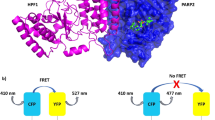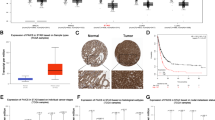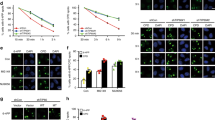Abstract
The overexpression of human apurinic/apyrimidinic (AP) endonuclease 1 (APE1/Ref-1), a key enzyme in the DNA base excision repair (BER) pathway, is often associated with tumor cell resistance to various anticancer drugs. In this study, we examined the molecular basis of transcriptional regulatory (nonrepair) function of APE1 in promoting resistance to certain types of drugs. We have recently shown that APE1 stably interacts with Y-box-binding protein 1 (YB-1), and acts as its coactivator for the expression of multidrug resistance gene MDR1, thereby causing drug resistance. In this study, we show, to the best of our knowledge, for the first time that APE1 is stably associated with the basic transcription factor RNA polymerase II (RNA pol II) and the coactivator p300 on the endogenous MDR1 promoter. The depletion of APE1 significantly reduces YB-1–p300 recruitment to the promoter, resulting in reduced RNA pol II loading. Drug-induced APE1 acetylation, which is mediated by p300, enhances formation of acetylated APE1 (AcAPE1)–YB-1–p300 complex on the MDR1 promoter. Enhanced recruitment of this complex increases MDR1 promoter-dependent luciferase activity and its endogenous expression. Using APE1-downregulated cells and cells overexpressing wild-type APE1 or its nonacetylable mutant, we have demonstrated that the loss of APE1's acetylation impaired MDR1 activation and sensitizes the cells to cisplatin or etoposide. We have thus established the basis for APE1's acetylation-dependent regulatory function in inducing MDR1-mediated drug resistance.
This is a preview of subscription content, access via your institution
Access options
Subscribe to this journal
Receive 50 print issues and online access
$259.00 per year
only $5.18 per issue
Buy this article
- Purchase on Springer Link
- Instant access to full article PDF
Prices may be subject to local taxes which are calculated during checkout






Similar content being viewed by others
References
Ahmad S, Glazer RI . (1993). Expression of the antisense cDNA for protein kinase C alpha attenuates resistance in doxorubicin-resistant MCF-7 breast carcinoma cells. Mol Pharmacol 43: 858–862.
Ahmad S, Safa AR, Glazer RI . (1994). Modulation of P-glycoprotein by protein kinase C alpha in a baculovirus expression system. Biochemistry 33: 10313–10318.
Ambudkar SV, Sauna ZE, Gottesman MM, Szakacs G . (2005). A novel way to spread drug resistance in tumor cells: functional intercellular transfer of P-glycoprotein (ABCB1). Trends Pharmacol Sci 26: 385–387.
Ando K, Hirao S, Kabe Y, Ogura Y, Sato I, Yamaguchi Y et al. (2008). A new APE1/Ref-1-dependent pathway leading to reduction of NF-kappaB and AP-1, and activation of their DNA-binding activity. Nucleic Acids Res 36: 4327–4336.
Bapat A, Fishel M, Kelley MR . (2009). Going Ape as an approach to cancer therapeutics. Antioxid Redox Signal 11: 651–668.
Bargou RC, Jurchott K, Wagener C, Bergmann S, Metzner S, Bommert K et al. (1997). Nuclear localization and increased levels of transcription factor YB-1 in primary human breast cancers are associated with intrinsic MDR1 gene expression. Nat Med 3: 447–450.
Bhakat KK, Izumi T, Yang SH, Hazra TK, Mitra S . (2003a). Role of acetylated human AP-endonuclease (APE1/Ref-1) in regulation of the parathyroid hormone gene. EMBO J 22: 6299–6309.
Bhakat KK, Mantha AK, Mitra S . (2009). Transcriptional regulatory functions of mammalian AP-endonuclease (APE1/Ref-1), an essential multifunctional protein. Antioxid Redox Signal 11: 621–638.
Bhakat KK, Mitra S . (2000). Regulation of the human O(6)-methylguanine-DNA methyltransferase gene by transcriptional coactivators cAMP response element-binding protein-binding protein and p300. J Biol Chem 275: 34197–34204.
Bhakat KK, Mokkapati SK, Boldogh I, Hazra TK, Mitra S . (2006). Acetylation of human 8-oxoguanine-DNA glycosylase by p300 and its role in 8-oxoguanine repair in vivo. Mol Cell Biol 26: 1654–1665.
Bhakat KK, Yang SH, Mitra S . (2003b). Acetylation of human AP-endonuclease 1, a critical enzyme in DNA repair and transcription regulation. Methods Enzymol 371: 292–300.
Bhattacharyya A, Chattopadhyay R, Burnette BR, Cross JV, Mitra S, Ernst PB et al. (2009). Acetylation of apurinic/apyrimidinic endonuclease-1 regulates Helicobacter pylori-mediated gastric epithelial cell apoptosis. Gastroenterology 136: 2258–2269.
Blobel GA . (2000). CREB-binding protein and p300: molecular integrators of hematopoietic transcription. Blood 95: 745–755.
Bobola MS, Finn LS, Ellenbogen RG, Geyer JR, Berger MS, Braga JM et al. (2005). Apurinic/apyrimidinic endonuclease activity is associated with response to radiation and chemotherapy in medulloblastoma and primitive neuroectodermal tumors. Clin Cancer Res 11: 7405–7414.
Busso CS, Iwakuma T, Izumi T . (2009). Ubiquitination of mammalian AP endonuclease (APE1) regulated by the p53–MDM2 signaling pathway. Oncogene 28: 1616–1625.
Chattopadhyay R, Das S, Maiti AK, Boldogh I, Xie J, Hazra TK et al. (2008). Regulatory role of human AP-endonuclease (APE1/Ref-1) in YB-1-mediated activation of the multidrug resistance gene MDR1. Mol Cell Biol 28: 7066–7080.
Chaudhary PM, Roninson IB . (1993). Induction of multidrug resistance in human cells by transient exposure to different chemotherapeutic drugs. J Natl Cancer Inst 85: 632–639.
Cho H, Orphanides G, Sun X, Yang XJ, Ogryzko V, Lees E et al. (1998). A human RNA polymerase II complex containing factors that modify chromatin structure. Mol Cell Biol 18: 5355–5363.
Curtis CD, Thorngren DL, Ziegler YS, Sarkeshik A, Yates JR, Nardulli AM . (2009). Apurinic/apyrimidinic endonuclease 1 alters estrogen receptor activity and estrogen-responsive gene expression. Mol Endocrinol 23: 1346–1359.
Das S, Chattopadhyay R, Bhakat KK, Boldogh I, Kohno K, Prasad R et al. (2007). Stimulation of NEIL2-mediated oxidized base excision repair via YB-1 interaction during oxidative stress. J Biol Chem 282: 28474–28484.
Demple B, Harrison L . (1994). Repair of oxidative damage to DNA: enzymology and biology. Annu Rev Biochem 63: 915–948.
Doetsch PW, Cunningham RP . (1990). The enzymology of apurinic/apyrimidinic endonucleases. Mutat Res 236: 173–201.
Evans AR, Limp-Foster M, Kelley MR . (2000). Going APE over ref-1. Mutat Res 461: 83–108.
Fan J, Wilson III DM . (2005). Protein-protein interactions and posttranslational modifications in mammalian base excision repair. Free Radic Biol Med 38: 1121–1138.
Fantini D, Vascotto C, Deganuto M, Bivi N, Gustincich S, Marcon G et al. (2008). APE1/Ref-1 regulates PTEN expression mediated by Egr-1. Free Radic Res 42: 20–29.
Fishel ML, Kelley MR . (2007). The DNA base excision repair protein Ape1/Ref-1 as a therapeutic and chemopreventive target. Mol Aspects Med 28: 375–395.
Fuchs S, Philippe J, Corvol P, Pinet F . (2003). Implication of Ref-1 in the repression of renin gene transcription by intracellular calcium. J Hypertens 21: 327–335.
Germann UA, Chambers TC . (1998). Molecular analysis of the multidrug transporter, P-glycoprotein. Cytotechnology 27: 31–60.
Goldstein LJ, Galski H, Fojo A, Willingham M, Lai SL, Gazdar A et al. (1989). Expression of a multidrug resistance gene in human cancers. J Natl Cancer Inst 81: 116–124.
Gottesman MM, Fojo T, Bates SE . (2002). Multidrug resistance in cancer: role of ATP-dependent transporters. Nat Rev Cancer 2: 48–58.
Gottesman MM, Pastan I . (1993). Biochemistry of multidrug resistance mediated by the multidrug transporter. Annu Rev Biochem 62: 385–427.
Higashi K, Inagaki Y, Fujimori K, Nakao A, Kaneko H, Nakatsuka I . (2003). Interferon-gamma interferes with transforming growth factor-beta signaling through direct interaction of YB-1 with Smad3. J Biol Chem 278: 43470–43479.
Izumi T, Brown DB, Naidu CV, Bhakat KK, Macinnes MA, Saito H et al. (2005). Two essential but distinct functions of the mammalian abasic endonuclease. Proc Natl Acad Sci USA 102: 5739–5743.
Izumi T, Wiederhold LR, Roy G, Roy R, Jaiswal A, Bhakat KK et al. (2003). Mammalian DNA base excision repair proteins: their interactions and role in repair of oxidative DNA damage. Toxicology 193: 43–65.
Jayaraman L, Murthy KG, Zhu C, Curran T, Xanthoudakis S, Prives C . (1997). Identification of redox/repair protein Ref-1 as a potent activator of p53. Genes Dev 11: 558–570.
Jiang Y, Guo C, Vasko MR, Kelley MR . (2008). Implications of apurinic/apyrimidinic endonuclease in reactive oxygen signaling response after cisplatin treatment of dorsal root ganglion neurons. Cancer Res 68: 6425–6434.
Jin S, Scotto KW . (1998). Transcriptional regulation of the MDR1 gene by histone acetyltransferase and deacetylase is mediated by NF-Y. Mol Cell Biol 18: 4377–4384.
Kaina B, Christmann M . (2002). DNA repair in resistance to alkylating anticancer drugs. Int J Clin Pharmacol Ther 40: 354–367.
Kaina B, Ochs K, Grosch S, Fritz G, Lips J, Tomicic M et al. (2001). BER, MGMT, and MMR in defense against alkylation-induced genotoxicity and apoptosis. Prog Nucleic Acid Res Mol Biol 68: 41–54.
Kelley MR, Cheng L, Foster R, Tritt R, Jiang J, Broshears J et al. (2001). Elevated and altered expression of the multifunctional DNA base excision repair and redox enzyme Ape1/ref-1 in prostate cancer. Clin Cancer Res 7: 824–830.
Kohno K, Izumi H, Uchiumi T, Ashizuka M, Kuwano M . (2003). The pleiotropic functions of the Y-box-binding protein, YB-1. Bioessays 25: 691–698.
Kohno K, Sato S, Takano H, Matsuo K, Kuwano M . (1989). The direct activation of human multidrug resistance gene (MDR1) by anticancer agents. Biochem Biophys Res Commun 165: 1415–1421.
Kohno K, Tanimura H, Sato S, Nakayama Y, Makino Y, Wada M et al. (1994). Cellular control of human multidrug resistance 1 (MDR-1) gene expression in absence and presence of gene amplification in human cancer cells. J Biol Chem 269: 20503–20508.
Kovacic P . (2007). Unifying mechanism for anticancer agents involving electron transfer and oxidative stress: clinical implications. Med Hypotheses 69: 510–516.
Kovacic P, Osuna Jr JA . (2000). Mechanisms of anti-cancer agents: emphasis on oxidative stress and electron transfer. Curr Pharm Des 6: 277–309.
Kuninger DT, Izumi T, Papaconstantinou J, Mitra S . (2002). Human AP-endonuclease 1 and hnRNP-L interact with a nCaRE-like repressor element in the AP-endonuclease 1 promoter. Nucleic Acids Res 30: 823–829.
Loeb LA, Preston BD . (1986). Mutagenesis by apurinic/apyrimidinic sites. Annu Rev Genet 20: 201–230.
Mantha AK, Oezguen N, Bhakat KK, Izumi T, Braun W, Mitra S . (2008). Unusual role of a cysteine residue in substrate binding and activity of human AP-endonuclease 1. J Mol Biol 379: 28–37.
Matsumoto Y, Kim K . (1995). Excision of deoxyribose phosphate residues by DNA polymerase beta during DNA repair. Science 269: 699–702.
McNeill DR, Lam W, DeWeese TL, Cheng YC, Wilson III DM . (2009). Impairment of APE1 function enhances cellular sensitivity to clinically relevant alkylators and antimetabolites. Mol Cancer Res 7: 897–906.
Mitra S, Izumi T, Boldogh I, Bhakat KK, Hill JW, Hazra TK . (2002). Choreography of oxidative damage repair in mammalian genomes. Free Radic Biol Med 33: 15–28.
Mujtaba S, He Y, Zeng L, Farooq A, Carlson JE, Ott M et al. (2002). Structural basis of lysine-acetylated HIV-1 Tat recognition by PCAF bromodomain. Mol Cell 9: 575–586.
Neish AS, Anderson SF, Schlegel BP, Wei W, Parvin JD . (1998). Factors associated with the mammalian RNA polymerase II holoenzyme. Nucleic Acids Res 26: 847–853.
Okamura H, Yoshida K, Sasaki E, Morimoto H, Haneji T . (2004). Transcription factor NF-Y regulates mdr1 expression through binding to inverted CCAAT sequence in drug-resistant human squamous carcinoma cells. Int J Oncol 25: 1031–1037.
Okazaki T, Chung U, Nishishita T, Ebisu S, Usuda S, Mishiro S et al. (1994). A redox factor protein, ref1, is involved in negative gene regulation by extracellular calcium. J Biol Chem 269: 27855–27862.
Ordway JM, Eberhart D, Curran T . (2003). Cysteine 64 of Ref-1 is not essential for redox regulation of AP-1 DNA binding. Mol Cell Biol 23: 4257–4266.
Pajic M, Iyer JK, Kersbergen A, van der Burg E, Nygren AO, Jonkers J et al. (2009). Moderate increase in MDR1a/1b expression causes in vivo resistance to doxorubicin in a mouse model for hereditary breast cancer. Cancer Res 69: 6396–6404.
Rahman I . (2002). Oxidative stress, transcription factors and chromatin remodelling in lung inflammation. Biochem Pharmacol 64: 935–942.
Ramana CV, Boldogh I, Izumi T, Mitra S . (1998). Activation of apurinic/apyrimidinic endonuclease in human cells by reactive oxygen species and its correlation with their adaptive response to genotoxicity of free radicals. Proc Natl Acad Sci USA 95: 5061–5066.
Robertson KA, Bullock HA, Xu Y, Tritt R, Zimmerman E, Ulbright TM et al. (2001). Altered expression of Ape1/ref-1 in germ cell tumors and overexpression in NT2 cells confers resistance to bleomycin and radiation. Cancer Res 61: 2220–2225.
Robertson KA, Hill DP, Xu Y, Liu L, Van Epps S, Hockenbery DM et al. (1997). Down-regulation of apurinic/apyrimidinic endonuclease expression is associated with the induction of apoptosis in differentiating myeloid leukemia cells. Cell Growth Differ 8: 443–449.
Shen DW, Fojo A, Chin JE, Roninson IB, Richert N, Pastan I et al. (1986). Human multidrug-resistant cell lines: increased mdr1 expression can precede gene amplification. Science 232: 643–645.
Singhal RK, Prasad R, Wilson SH . (1995). DNA polymerase beta conducts the gap-filling step in uracil-initiated base excision repair in a bovine testis nuclear extract. J Biol Chem 270: 949–957.
Tell G, Quadrifoglio F, Tiribelli C, Kelley MR . (2009). The many functions of APE1/Ref-1: not only a DNA repair enzyme. Antioxid Redox Signal 11: 601–620.
Vascotto C, Cesaratto L, Zeef LA, Deganuto M, D'Ambrosio C, Scaloni A et al. (2009). Genome-wide analysis and proteomic studies reveal APE1/Ref-1 multifunctional role in mammalian cells. Proteomics 9: 1058–1074.
Walker LJ, Robson CN, Black E, Gillespie D, Hickson ID . (1993). Identification of residues in the human DNA repair enzyme HAP1 (Ref-1) that are essential for redox regulation of Jun DNA binding. Mol Cell Biol 13: 5370–5376.
Wang D, Luo M, Kelley MR . (2004). Human apurinic endonuclease 1 (APE1) expression and prognostic significance in osteosarcoma: enhanced sensitivity of osteosarcoma to DNA damaging agents using silencing RNA APE1 expression inhibition. Mol Cancer Ther 3: 679–686.
Xanthoudakis S, Curran T . (1992). Identification and characterization of Ref-1, a nuclear protein that facilitates AP-1 DNA-binding activity. EMBO J 11: 653–665.
Xanthoudakis S, Miao G, Wang F, Pan YC, Curran T . (1992). Redox activation of Fos-Jun DNA binding activity is mediated by a DNA repair enzyme. EMBO J 11: 3323–3335.
Xu Y, Moore DH, Broshears J, Liu L, Wilson TM, Kelley MR . (1997). The apurinic/apyrimidinic endonuclease (APE/Ref-1) DNA repair enzyme is elevated in premalignant and malignant cervical cancer. Anticancer Res 17: 3713–3719.
Yamamori T, DeRicco J, Naqvi A, Hoffman TA, Mattagajasingh I, Kasuno K et al. (2010). SIRT1 deacetylates APE1 and regulates cellular base excision repair. Nucleic Acids Res 38: 832–845.
Yoshida M, Kijima M, Akita M, Beppu T . (1990). Potent and specific inhibition of mammalian histone deacetylase both in vivo and in vitro by Trichostatin A. J Biol Chem 265: 17174–17179.
Yu G, Ahmad S, Aquino A, Fairchild CR, Trepel JB, Ohno S et al. (1991). Transfection with protein kinase C alpha confers increased multidrug resistance to MCF-7 cells expressing P-glycoprotein. Cancer Commun 3: 181–189.
Acknowledgements
We acknowledge the help of Dr Gianluca Tell, University of Udine, Italy for the APE1 siRNA construct, Larry J Bellot, University of Texas Medical Branch, Galveston and Dr Ranajay Chattopadhyay, University of Virginia, Charlottesville in this study. This study was supported by Grants: RO1 ESO8457, RO1 CA53791 and P50 ES66076 to SM.
Author information
Authors and Affiliations
Corresponding author
Ethics declarations
Competing interests
The authors declare no conflict of interest.
Rights and permissions
About this article
Cite this article
Sengupta, S., Mantha, A., Mitra, S. et al. Human AP endonuclease (APE1/Ref-1) and its acetylation regulate YB-1-p300 recruitment and RNA polymerase II loading in the drug-induced activation of multidrug resistance gene MDR1. Oncogene 30, 482–493 (2011). https://doi.org/10.1038/onc.2010.435
Received:
Revised:
Accepted:
Published:
Issue Date:
DOI: https://doi.org/10.1038/onc.2010.435
Keywords
This article is cited by
-
Circular RNA cFAM210A, degradable by HBx, inhibits HCC tumorigenesis by suppressing YBX1 transactivation
Experimental & Molecular Medicine (2023)
-
P-gp expression inhibition mediates placental glucocorticoid barrier opening and fetal weight loss
BMC Medicine (2021)
-
YBX1 mediates autophagy by targeting p110β and decreasing the sensitivity to cisplatin in NSCLC
Cell Death & Disease (2020)
-
CREBBP and p300 lysine acetyl transferases in the DNA damage response
Cellular and Molecular Life Sciences (2018)
-
Mammalian APE1 controls miRNA processing and its interactome is linked to cancer RNA metabolism
Nature Communications (2017)



